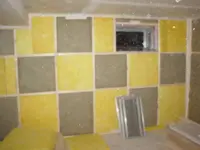Tukkis,
> Do they have to be floor to ceiling? <
No, but it's better that way. The goal with all bass trapping is to cover as much of the room's surface as possible. If you cover 30% of the surfaces with traps you'll get better results than if you cover only 5%. So building them shorter only makes the trapping less efficient.
> Can they be angled so I can put them in a corner? <
Yes, but you're much better off putting two traps flat on the walls in each corner since, again, that gives more surface coverage.
> Can I adjust the width of the panels so I don't have to make as many or do they have to be that size? <
You probably can vary the width, though I've never done that so I can't say for sure what might happen. But I wouldn't change it too much. If you make them too narrow, the wood panel will be too stiff to flex properly. And too wide will likely let the panel flop around too much.
> In your design it say's 1" rigid fiberglass. Is 1" enough for lows? <
Yes, because the fiberglass is not what's absorbing the sound. The fiberglass just lowers the Q of the trap so it absorbs a wider range, and one-inch 703 is adequate for that.
> could I angle them to achieve the same effect? <
Sure. A couple of degrees ought to do it.
--Ethan



